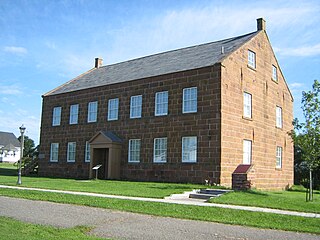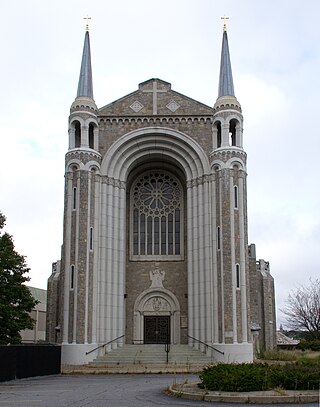
A credit union, a type of financial institution similar to a commercial bank, is a member-owned nonprofit financial cooperative. Credit unions generally provide services to members similar to retail banks, including deposit accounts, provision of credit, and other financial services. In several African countries, credit unions are commonly referred to as SACCOs.
Little Canada is a name for any of the various communities where French Canadians congregated upon emigrating to the United States, in particular New England, in the 19th and early 20th centuries. A variant of Canadian French known as New England French is still spoken in parts of New England.
Sainte-Marie or Ste. Marie may refer to the several places:

Sainte-Marie among the Hurons was a French Jesuit settlement in Huronia or Wendake, the land of the Wendat, near modern Midland, Ontario, from 1639 to 1649. It was the first European settlement in what is now the province of Ontario. Eight missionaries from Sainte-Marie were martyred, and were canonized by the Catholic Church in 1930. Sainte-Marie Among the Hurons was designated a National Historic Site of Canada in 1920. A reconstruction of the mission now operates as a living museum.

Caisse populaire acadienne ltée, operating as UNI Financial Cooperation, is a Francophone credit union based in New Brunswick, Canada whose members are primarily Acadians. UNI's administrative headquarters are in Caraquet on the Acadian Peninsula.

Cooperative banking is retail and commercial banking organized on a cooperative basis. Cooperative banking institutions take deposits and lend money in most parts of the world.

The Farmers' Bank of Rustico operated in the village of South Rustico, Prince Edward Island, from 1864 to 1894. It is often considered to have been the first community-based bank in Canada. Founded and managed under the leadership of Father Georges-Antoine Belcourt (1803-1874), the Farmer's Bank of Rustico was established on April 21, 1863. The bank received Royal Assent for its act of incorporation at the Court of Windsor on April 7, 1864." The first president was farmer Jerome Doiron, and the first cashier was Marinus Blanchard, a local school teacher.
Credit unions are not-for-profit financial cooperatives. In the early stages of development of a nation's financial system, unserved and underserved populations must rely on risky and expensive informal financial services from sources like money lenders, ROSCAs and saving at home. Credit unions proved they could meet demand for financial services that banks could not: from professional, middle class and poorer people. Those that served poorer urban and rural communities became an important source of microfinance.

Pierre Hevey was a Canadian-born American priest, and second pastor of Ste. Marie Church in Manchester, New Hampshire, in the early 20th century. He played a key role in the establishment of the first credit union in the United States on November 24, 1908, to help his parishioners save money and access credit at a reasonable cost.
Attorney Joseph Boivin was a co-founder and first president of the first credit union established in the United States, St. Marie's Cooperative Credit Association. The son of Stanislas and Marie (Doucet) Boivin, Joseph Auguste Boivin was born September 21, 1866 in Coaticook, Quebec, Canada. Mr. Boivin contracted polio as a child and lost one leg to complications of the illness. He studied at Saint Hyacinthe College, Coaticook, and lived for several years in Saint-Hyacinthe, Quebec. Boivin immigrated to Manchester, New Hampshire, on October 1, 1883. He studied law in the offices of Burnham, Brown, Jones and Warren, and later with Judge George W. Prescott. He was admitted to the New Hampshire Bar in December 1899 and, subsequently, to the Hillsborough County Bar Association. He studied at St. Anselm College in neighboring Goffstown, where he also taught French. He married Miss Emma Gilbert of Lewiston, Maine, in September 1901; they had four children between 1902–1907: Dominique, Therese, Gilberte and Gertrude.

Credit unions in the United States served 100 million members, comprising 43.7% of the economically active population, in 2014. U.S. credit unions are not-for-profit, cooperative, tax-exempt organizations. The clients of the credit unions become partners of the financial institution and their presence focuses in certain neighborhoods because they center their services in one specific community. As of March 2020, the largest American credit union was Navy Federal Credit Union, serving U.S. Department of Defense employees, contractors, and families of servicepeople, with over $125 billion in assets and over 9.1 million members. Total credit union assets in the U.S. reached $1 trillion as of March 2012. Approximately 236,000 people were directly employed by credit unions per data derived from the 2012 National Credit Union Administration (NCUA) Credit Union Directory. As of 2019, there were 5,236 federally insured credit unions with 120.4 million members, and deposits of $1.22 trillion.

Ste. Marie Church is a Roman Catholic church on the West Side of Manchester, New Hampshire, in the United States. The church was founded to serve the needs of French-Canadian Catholic immigrants to New Hampshire. The Gothic Revival church building is a prominent feature on the Manchester skyline, and dominates the West Side skyline. The building is perched atop the plateau that makes up Rimmon Heights, and forms one of the focal points of the Notre Dame neighborhood, along with Lafayette Park across the street.

Groupe BPCE is a major French banking group formed by the 2009 merger of two major retail banking groups, Groupe Caisse d'Épargne and Groupe Banque Populaire. As of 2021, it was France's fourth largest bank, the seventh largest in Europe, and the nineteenth in the world by total assets. It has more than 8,200 branches nationwide under their respective brand names serving nearly 150 million customers. It is Europe's largest bank by revenue, ahead of BNP Paribas and HSBC. It is considered a global systemically important bank (G-SIB) by the Financial Stability Board.

Donat R. Baribault (1885–1970) was an American architect who designed a number of Catholic churches, schools, convents and rectories in Western Massachusetts and New Hampshire.
The West Side is a large area defining many neighborhoods in the city of Manchester, New Hampshire, in the United States. It consists of all parts of the city that lie west of the Merrimack River and includes the neighborhoods of Northwest Manchester, Rimmon Heights, Notre Dame, Piscataquog, Wolfe Park, and Mast Road. It lies just to the east of the community of Pinardville in the neighboring town of Goffstown.

Holy Name of Mary Proto-Cathedral, also known as St. Mary Proto-Cathedral, is a historic Roman Catholic parish church in Sault Ste. Marie, Michigan, United States that was formerly a cathedral church and the first Cathedral, hence "Proto-Cathedral", of the Roman Catholic Diocese of Marquette. It is the oldest parish and oldest cathedral parish in Michigan, and the third oldest parish in the United States. While the present church edifice, the fifth for the Parish, dates from 1881, the Parish began in 1668 as a Jesuit mission. It was listed on the National Register of Historic Places in 1984 and designated a State of Michigan historic site in 1989. The Proto-Cathedral was the (first) Cathedral of the Diocese of Marquette when it was denominated the "Diocese of Sault Sainte Marie", which diocesan title is presently that of a titular episcopal see.
St. Mary's Bank is a credit union based in Manchester, New Hampshire. Founded in 1908, it is the first credit union in the United States.

The Sainte Marie Roman Catholic Church Parish Historic District, located in the city of Manchester, New Hampshire, United States, includes seven red brick buildings dating from the late 19th century and 20th century. The district was placed on the National Register of Historic Places in September 2019.
The presence of the French language and the New England variety of French, in New Hampshire, has been around since the foundation of the state. Workers in the area even developed their own dialect of French.














